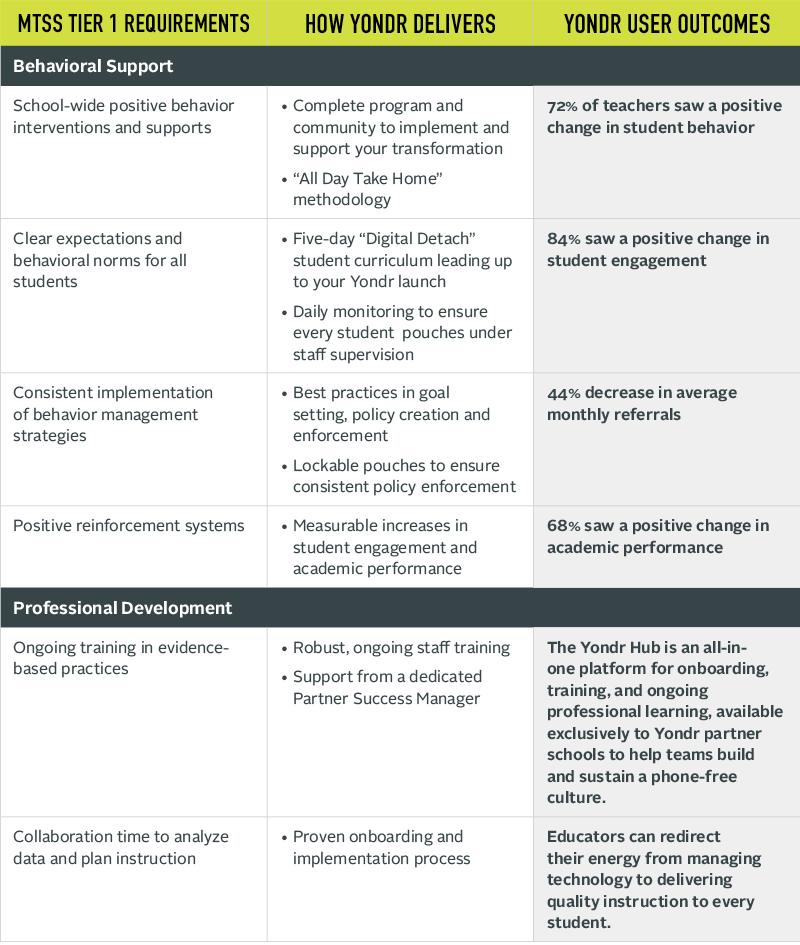Phone-Free Schools: MTSS and Student Success
Yondr's Phone-Free Schools Program aligns with MTSS Tier 1 strategies to boost focus, reduce disruptions, and create optimal learning environments for all students.
All students struggle with managing phone usage during the school day. Optimal learning conditions aren’t possible when teens are spending nearly a quarter of the school day on their phones. According to Pew Research, 72 percent of high school teachers say that students being distracted by cellphones is a major problem in their classroom.
Teachers simply can’t compete with the lure of online content. But what if we didn't have to compete at all?
As educators seek effective solutions, phone-free school policies are emerging as powerful Tier 1 interventions within the Multi-Tiered System of Supports (MTSS) framework.
“[Going phone-free]...is a game changer, and it’s hard to understand until you do it,” says Ewell Fuller, principal of Alabama-based Stanhope Elmore High School, which has implemented the Yondr Phone-Free Schools Program. “It’s keeping the chaos that comes with social media from interrupting the school day.”
Implementation as prevention, not punishment
MTSS emphasizes prevention over intervention, and Yondr excels in this area. By removing devices proactively for all students, schools can reduce issues like cyberbullying during school hours, academic dishonesty involving phones and social conflicts that may begin online but too often spill into classrooms.
The Yondr Program provides a respectful, non-punitive method for creating phone-free environments. Students retain possession of their devices while schools maintain learning-focused spaces. We see success when every student uses Yondr together as a Tier I Solution, which helps increase buy-in and ensures that all students access the benefits of a phone-free learning environment. Rather than singling out students who are already struggling with phone usage or academics, Yondr simply eliminates the temptation.
It’s important to note that phone-free solutions like Yondr are not effective when implemented solely as punishment or disciplinary measures. Success depends on positioning phone-free policies as supportive learning tools rather than disciplinary actions.
LEARN MORE ABOUT PHONE-FREE SCHOOLS
•
LEARN MORE ABOUT PHONE-FREE SCHOOLS •
Phone-free schools as a Tier 1 intervention
MTSS Tier 1 focuses on universal supports that benefit all students by creating optimal learning conditions.
Phone-free school policies supported by programs like Yondr represent a return to fundamentals—creating environments where learning takes priority. As a Tier 1 MTSS support, Yondr:
Allows all students to participate in a distraction-free learning environment.
Creates an environment that supports a reduction in disciplinary referrals.
Allows teachers to focus on teaching rather than phone management strategies.
When students place their phones in Yondr lockable pouches at the school entrance, they're not just securing a device; they're stepping into an environment intentionally designed for learning. Rather than being viewed as a punitive measure, this phone-free approach mirrors other Tier 1 strategies that schools already implement for all students, including positive behavior supports, consistent classroom routines, and school-wide expectations.
Understanding the intention of MTSS T2 and T3 interventions
Parents and educators often ask, why not just target phone policies toward students who struggle with device management? Rather than singling out students who struggle with device-related issues, schools can proactively eliminate these barriers for everyone.
While some students may need additional Tier 2 or Tier 3 support to address phone-related issues, all students benefit from the opportunity to spend their full school day engaged in learning, free from the distractions and stresses that phones create. Addressing phone usage as a Tier 2 or Tier 3 intervention is hard to sustain and ineffective for teachers, administrators, and most importantly students.
For example, utilized as a Tier 2 intervention, only certain students surrender their phones. Those students feel singled out and stigmatized while everyone else's devices continue to pull the focus away from learning. Teachers are still playing digital referee, and the classroom environment remains fractured.
Tier 3 approaches are even more problematic. When only one or two students have phone restrictions, they're essentially being punished while their classmates freely scroll through social media. Social dynamics become toxic, the learning environment stays chaotic for everyone, and teachers end up applying multiple rules simultaneously.
The question isn't whether schools can afford to implement phone-free policies, but whether they can afford not to. All students deserve learning environments optimized for their success, and implementing Yondr as a Tier 1 intervention to strengthen phone-free school communities delivers exactly that.
Learn how Yondr supports phone-free schools or reach out to team@overyondr.com to discuss implementing the program at your school.




